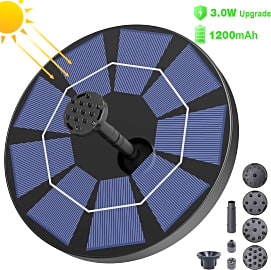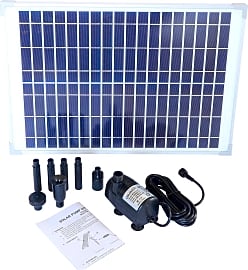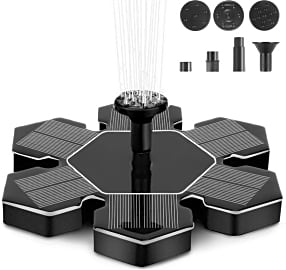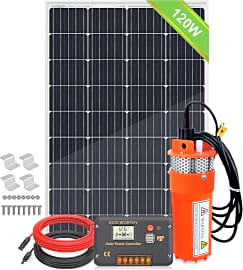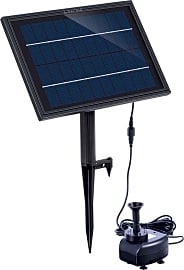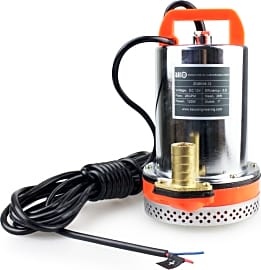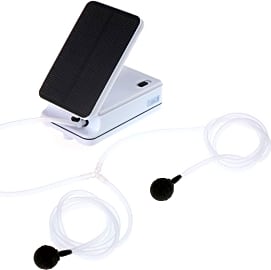The 10 Best Solar Water Pumps

This wiki has been updated 35 times since it was first published in December of 2016. Nothing adds charm and a sense of tranquility to a yard or patio like flowing water. Pumps powered by sunlight require minimal installation and maintenance, and are an eco-friendly way to create a pleasant display. We judged these solar-powered systems based on flow rate, lift capability, and expected longevity, so one should make a perfect addition to your fountain, pond, or birdbath. When users buy our independently chosen editorial choices, we may earn commissions to help fund the Wiki.
Editor's Notes
August 09, 2020:
Firstly, know that solar pumps aren’t ‘special pumps’ that have been designed differently from regular pumps; they are simply regular pumps that have been retrofitted with solar panels. Doing so can benefit a variety of applications that want to employ a more sustainable and cost-saving alternative to traditional electricity, but the use of solar water pumps as more eco-friendly, energy saving pond water pumps do seem to be by far their most common market adoption.
This is because solar pumps are largely limited by their size – the more power, the larger the solar panel you need – and pond pumps seem fit the right size for their limitations, and don’t demand as much power and water pressure as larger scale applications like irrigation and well pumping. A common type of design you’ll find are in the floating water fountains like Syihlon Submersible and Auka Fountain, which have DC motors attached to the bottom of their bases. These cap out at around 2-3W, since more power would require a much broader base.
Other options like the Lewisia Garden and Solariver Pump Kit are simply solar panels wired to DC pumps, and these often employ panels that can go up to 20W. A peak 20-W panel would be maybe a little over a square foot since one square meter will give you around 150W. Much larger than this capacity and they aren’t usually sold as a kit, so if you want a 150-W solar water pump for instance, you will probably have to buy a DC pump and solar panels separately, or if you want to hook up an AC pump, then you’ll also need an inverter, since solar panels produce DC. Since 2015, solar panels have become about 20% cheaper and 3-4% more efficient, with trends suggesting that this will continue - though, they may never be small and cheap enough to justify buying enough to run a powerful pump. For convenience, there are a few options out there like the Eco-Worthy 120W that I've added, that sell a pump with a solar panel, which means that you don't have to go about and source everything yourself.
Aside from the aforementioned Eco-Worthy, the other exception to this water-fountain-type solar pump in this list is the Baco Engineering Farm & Ranch, which is basically a DC pump that’s been marketed to work well with solar panels. I thought I’d leave it in to give you some variety, on the off-chance that you weren’t looking for something to stick into your pond or water body. Also, do note that the Sunsbell Aerator is an aerator pump, not a water pump, and while we do have a separate list for aerator pumps, I've left the option in to give our list some variety, plus a specific subset of people who search for a water pump may in fact be looking an aerator pump.
May 21, 2019:
In this update, the Solatec Submersible retains its No. 1 spot on our list, thanks to its quiet operation, four different spray types, and ability to function well, even on days when the Sun is nowhere in sight. The Lewisia Garden moves up a couple of notches, thanks to its generous cord length between the pump and panel (which makes it easy to place your fountain in the shade, if you prefer), multiple fountain heads, and quick startup time once sunlight hits the panel.
Joining the list is the Lewisia 5W, which boasts five colored LED that lights will put on a vibrant show after dark. And it's not just a pretty face; it's equipped with an efficient, long-lasting brushless motor.
A Brief History Of Water Pumps
Cities were able to build these on a massive scale, and the first public waterworks came about as a result.
Without access to clean drinking water, there can be no civilization. For the early part of human history, this meant never straying far from rivers and lakes, where your next drink was just a short walk away. The creation of the water pump, however, would change all that, enabling humans to live where they pleased.
The first known water pump was the shadoof, an irrigation tool used by the ancient Egyptians around 2000 B.C.E. Basically a long pole on a fulcrum with a bucket at the end, the shadoof allowed Egyptian farmers to transport water from the Nile and deposit it directly on top of their crops. This was backbreaking labor, and you could only move enough liquid to water about an acre of crops, but it was a start.
There wouldn't be much progress made on pumps until 1700 years later, when the Greek mathematician Archimedes developed a screw pump that would later bear his name. The idea was to have a screw inside of a cylinder, and when turned, it would draw water from its source and bring it to the surface of the pump.
The Archimedes screw is still in use today, with motors replacing the manual labor previously needed to turn it. These pumps are excellent for separating water from debris, and as such are used in wastewater facilities and sewage treatment plants.
In 1654, the German scientist Otto von Guericke created a device that used an air gun cylinder and a piston to vacuum all of the air out of a vessel. It was quickly realized that this could be used to suck up water and move it, and thus the piston vacuum pump was born. These piston pumps would eventually form the basis of the hand pumps that were often found on farms in the 18th and 19th centuries.
With the dawn of the Industrial Revolution, however, more people began to leave their farms and move to the cities. This created a pressing need for a dependable, wide-scale water supply, and the steam pump was the answer. Cities were able to build these on a massive scale, and the first public waterworks came about as a result.
1962 saw the introduction of the variable-speed centrifugal pump. This new machine allowed you to regulate the amount of water sent out to each home by altering the pump's speed. This allowed for consistent water pressure even in times of high demand, forming the basis for modern water supplies.
Without water pumps, we would still be stuck living near the closest body of fresh water. These simple machines have been instrumental in our global expansion, and remain essential in our lives today. Indeed, pumps remain critical for ensuring a steady supply of water, keeping supplies clean, and maintaining proper air pressure in your old-school Reeboks.
Benefits Of A Solar Water Pump
Solar water pumps are ideal for small-scale use, such as watering gardens and livestock or providing drinking water. They're not as suitable for larger watering projects, as the motors can't generate enough energy to move massive amounts of liquid. Still, they're ideal for most consumer needs.
The most obvious benefit is the amount of energy savings they can provide.
The most obvious benefit is the amount of energy savings they can provide. Pumping water is no easy task, and you can quickly spend a small fortune in fuel or electricity costs just trying to keep the H2O flowing. As long as the solar panel gets plenty of light, one of these pumps can make sure that you always have water in the tap.
They're much better for the environment, as well. Not only are you decreasing your carbon footprint by eschewing fuel sources that pump out greenhouse gases, but you're also eliminating the possibility of a hazardous spill. After all, it's pretty hard to spill a barrel of sunshine (and if you do, that's how unicorns are made!).
In rural or underdeveloped areas, these pumps can be literal lifesavers. They're easy to transport and store, so you can use them only when necessary, or move them from community to community. If you live in a region where it's difficult to access fresh water, a solar pump is an excellent investment. They're inexpensive, low-maintenance, and best of all, they finally make that lazy ol' sun start pulling its weight.
Easy Ways To Limit Water Usage
While a solar water pump won't consume any fossil fuels, it can still encourage water waste if not used responsibly. Below are some tips to limit your consumption, so that there will be plenty of liquid to go around for everyone.
Below are some tips to limit your consumption, so that there will be plenty of liquid to go around for everyone.
The most obvious — and important — thing to do is check all of your lines for leaks. This is pure waste, and it adds up (especially for larger-scale uses like watering livestock), so don't dawdle when it comes to leak inspection. The average household wastes 10,000 gallons a year, so be fanatical about this. Check around the pump itself, and inspect all your toilets and fixtures.
Try not to let any water go to waste when you're actually using it, either. Don't let the tap run while you're doing dishes or brushing your teeth, and rinse your razor off in standing water. Garbage disposals go through a lot of water as well, so consider investing in a compost tumbler.
And while a lush, green garden is a wonderful thing, it's also extremely wasteful to maintain. Consider swapping your grass and other plants out for drought-resistant options that will soak up far less liquid. These can be every bit as gorgeous as conventional lawns, so your home's appearance doesn't have to suffer due to your eco-consciousness.
Managing your water usage doesn't have to be difficult or constricting. With a few simple changes, you can live a normal life while also helping save the planet. In a way, that might actually make you a superhero (but please don't go out in public wearing Spandex).


